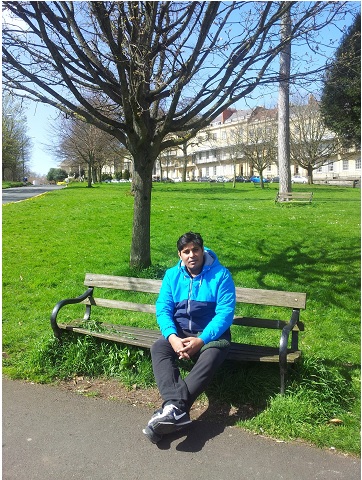
Dr. Nisar Ahmed was born (March 12, 1983) in a small beautiful village of Pakistan (Basti Abdul Rahman). He did his M.Sc from Islamia University Bahawalpur (IUB), Pakistan under the supervision of Prof. Abdul Jabbar (Natural Product Chemist). After getting a master’s degree in organic chemistry in 2004, he got a lectureship at the Bismillah College, Sadiq Abad, where he taught organic chemistry for one year. Subsequently he got an M.phil position in the laboratory of Prof. Abdul Malik, HEJ Research Institute of Chemistry, University of Karachi, Pakistan where he worked for two years on isolation of natural products. Then, he moved to South Korea as a researcher and later started his Ph.D (2009) at Pohang University of Science and Technology (POSTECH). He received his Ph.D degree in Organic/Supramolecular chemistry on the work entitled “Synthesis and binding studies of carbazole-urea and anthracene-imidazolium based receptors for anion and cation recognition”. After completing his Ph.D in February 2012, he started his Postdoc at Center for Superfunctional Materials, department of chemistry, POSTECH/UNIST, Korea. There he was chosen a group leader and he trained a number of students and researchers to explore their research capabilities. After completing his first Postdoc successfully, he becomes Novartis Post-Graduate Fellow in December 2013 at department of chemistry, University of Zurich, Switzerland (in Prof. Henning J. Jessen research group) and there he worked on a project entitled “Iterative construction of poly-ADP ribosylated peptides and development of new fluorescent probes for bioimaging in live cells.” After Novartis fellowship (2015), he got honorary research collaborator position at School of Chemistry, University of Bristol and worked on lithiation-borylation chemistry (methodology) in Aggarwal research group and then subsequently moved back toward supramolecular chemistry in Prof. Anthony P. Davis research group.
Contact: nisar.ahmed@bristol.ac.uk
1. “Halides with Fifteen Aliphatic C–H···Anion Interaction Sites”, Shi, G.; Tehrani, Z. A.; Dongwook, K.; Han, M. L.; Cho, W. J.; Youn, I. S.; Yousuf, M.; Ahmed, N.; Shirinfar, B.; Teator, A. J; Lastovickova, D. N.; Rasheed, L.; Myoung, S. L.; Bielawski, C. W.; Kim, K. S. Scientific Reports, 2016, 6, 30123.
2. “A New Selective “Turn-On” Small Fluorescent Cationic Probe for Recognition of RNA in Cells”, Ahmed, N.*; Shirinfar, B.; Madhav, M. V.; Choi, S-K.; Lee, K-M.; Jeon, W. B.; Park, Y. S.; Nam, H. G. Supramolecular Chemistry, 2015, 27, 478–483. *Corresponding author.
3. “Desymmetrization of myo-Inositol Derivatives by Lanthanide Catalyzed Phosphitylation with C2-Symmetric Phosphites” Duss, M.; Capolicchio, S.; Linden, A.; Ahmed, N.; Jessen, H. J. Bioorg. Med. Chem. 2015, 23, 2854-2861.
4. “Precise Tuning of Cationic Cyclophanes Towards Highly Selective Fluorogenic Recognition of Specific Bio-phosphate Anions”, Yousuf, M.; Ahmed, N.*; Shirinfar, B.; Miriyala, V.M.; Youn, I. S.; Kim, K.S. Org. Lett., 2014, 16, 2150–2153. *Corresponding author.
5. “Phosphate Esters and Anhydrides–Recent Strategies Targeting Nature’s Favoured Modifications”, Jessen, H. J.; Ahmed, N.; Hofer, A. Org. Biomol. Chem. 2014, 12, 3526–3530.
6. “Selective fluorescent detection of RNA in living cells by using imidazolium-based cyclophane”, Shirinfar, B.‡; Ahmed, N.‡; Park, Y.S.; Cho, G-S.; Youn, I. S.; Han, J-K.; Nam, H.G.; Kim, K. S. J. Am. Chem. Soc. 2013, 135, 90−93. ‡Co-first Authors.
7. “Highly Selective Detection of Guanosine-5´-triphosphate and Iodide by Fluorescent Benzimidazolium-Based Cyclophanes”, Ahmed, N.; Shirinfar, B.; Youn, I. S.; Yousuf, M.; Kim, K.S. Org. Biomol. Chem. 2013, 11, 6407–6413.
8. “Solution-processable conductive micro-hydrogels of nanoparticle/graphene platelets produced by reversible self-assembly and aqueous exfoliation” Le, N. H.; Seema, H.; Kemp, K.C.; Ahmed, N.; Park, S.; Kim, K.S. J. Mater. Chem. A, 2013, 1, 12900-12908.
9. “A simple pyrene-based highly sensitive turn-on fluorescent chemodosimeter for Hg2+”, Bist, A. Cho, S. J.; Ahmed, N.* J Incl Phenom Macrocycl Chem. 2013, 77, 75–81. *Corresponding author.
10. “A highly selective fluorescent chemosensor for guanosine-5′-triphosphate via eximer formation in aqueous solution of physiological pH”, Ahmed, N.; Shirinfar, B.; Youn, I. S.; Bist, A.; Suresh, V.; Kim, K. S. Chem. Commun. 2012, 48, 2662–2664.
Chem. Commun 2012, 48, 2650. Highlighted on “inside cover” of the journal
11. “Fluorogenic ditopic receptor for CH3CO2− and H2PO4− through conformational change”, Ahmed, N.*; Suresh, V.; Shirinfar, B.; Geronimo, I.; Hwang, I.-C.; Bist, A.; Kim, K. S. Org. Biomol. Chem. 2012, 10, 2094–2100. Paper in top 10 articles for February 2012.*Corresponding author.
12. “An Imidazolium-Based Fluorescent Cyclophane for the Selective Recognition of Iodide”, Suresh, V.; Ahmed, N.; Youn, I. S.; Kim, K. S. Chem. Asian J. 2012, 7, 658–663.
13. “cyclo-Bis(urea-3,6-dichlorocarbazole) as a chromogenic and fluorogenic receptor for anions and a selective sensor of zinc and copper cations”, Ahmed, N.; Geronimo, I.; Hwang, I.-C.; Singh, N. J.; Kim, K. S. Chem. Eur. J. 2011, 17. 8542–8548.
14. “Fluorescent Imidazolium-Based Cyclophane for Detection of Guanosine-5′-triphosphate and I– in Aqueous Solution of Physiological pH”, Ahmed, N.; Shirinfar, B.; Geronimo, I.; Kim, K. S. Org. Lett. 2011, 13, 5476–5479.
15. “Caragin, a new isoflavone from Caragana conferta”, Khan,R.; Fatima,I.; Ahmed, N.; Malik, A. J. Asian Nat. Prod. Res. 2008, 10, 823-825.